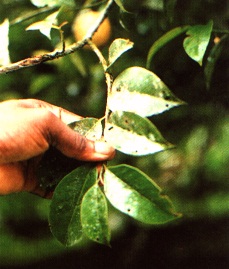
Leaf spot and shot hole (Colletotrichum gloeosporioides)
Sunken spots surrounded by a yellow halo are the initial symptoms. Subsequently the central portion of the necrotic region drops off resulting in shot hole symptoms. Dieback symptoms are also observed in some of the mature branches. On young seedlings drying of the leaves and subsequent defoliation are seen. The disease can be controlled by spraying 1% Bordeaux mixture two or three times during rainy season.
Thread blight
Two types of blights are noticed in nutmeg. The first one is a white thread blight wherein fine white hyphae aggregate to form fungal threads that traverse along the stem underneath the leaves in a fan shaped or irregular manner causing blight in the affected portions. The disease is caused by Marasmius pulcherima. The dried up leaves with mycelium form a major source of inoculum for the spread of the disease.The second type of blight is called horse hair blight. Fine black silky threads of the fungus form an irregular, loose network on the stems and leaves. These strands cause blight of leaves and stems. However, these threads hold up the detached, dried leaves on the tree, giving the appearance of a bird’s nest, when viewed from a distance. This disease is caused by Marasmius equicrinus. Both the diseases are severe under heavy shade.
Control
These diseases can be managed by adopting phytosanitation and shade regulation. In severely affected gardens, Bordeaux mixture 1% spraying may be undertaken in addition to cultural practices.
Fruit rot
Immature fruit split, fruit rot and fruit drop are serious in a majority of nutmeg gardens in Kerala. Immature fruit splitting and shedding are noticed in some trees without any apparent infection. In the case of fruit rot, the infection starts from the pedicel as dark lesions and gradually spreads to the fruit, causing brown discolouration of the rind resulting in rotting. In advanced stages, the mace also rots emitting a foul smell. Phytophthora sp. and Diplodia natalensis have been isolated from affected fruits. However, the reasons for fruit rot could be both pathological and physiological.
Control
Bordeaux mixture 1% may be sprayed when the fruits are half mature to reduce the incidence of the disease.
